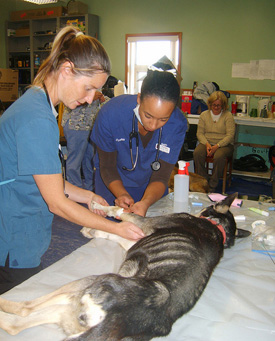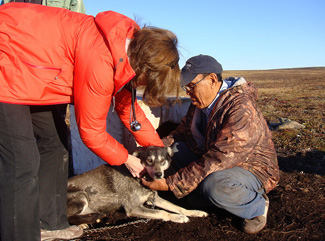From the Editor: Living in the Moment
Breed, Landrace and Purity:
what do they mean?
In the News
QTC Update: final report
Veterinary Service Plans for the Eastern Canadian Arctic
Piksuk Media Projects
CAAT Welcomed Back to Baker Lake
Join the Primitive Aboriginal Dog Society International
Media Review: People of the Seal, Part 2
IMHO: Relationships and Inclusion
Navigating This Site
Index of articles by subject
Index of back issues by volume number
Search The Fan Hitch
Articles to download and print
Ordering Ken MacRury's Thesis
Our comprehensive list of resources
Talk to The Fan Hitch
The Fan Hitch home page
ISDI home page
Editor's/Publisher's Statement
Editor: Sue Hamilton
Webmaster: Mark Hamilton
The Fan Hitch, Journal of
the Inuit Sled Dog, is published four times
a year. It is available at no cost online
at: https://thefanhitch.org.
The Fan Hitch welcomes your letters, stories, comments and suggestions. The editorial staff reserves the right to edit submissions used for publication.
Contents of The Fan Hitch are protected by international copyright laws. No photo, drawing or text may be reproduced in any form without written consent. Webmasters please note: written consent is necessary before linking this site to yours! Please forward requests to Sue Hamilton, 55 Town Line Rd., Harwinton, Connecticut 06791, USA or mail@thefanhitch.org.
This site is dedicated to the Inuit Dog as well as related Inuit culture and traditions. It is also home to The Fan Hitch, Journal of the Inuit Sled Dog.
The Fan Hitch welcomes your letters, stories, comments and suggestions. The editorial staff reserves the right to edit submissions used for publication.
Contents of The Fan Hitch are protected by international copyright laws. No photo, drawing or text may be reproduced in any form without written consent. Webmasters please note: written consent is necessary before linking this site to yours! Please forward requests to Sue Hamilton, 55 Town Line Rd., Harwinton, Connecticut 06791, USA or mail@thefanhitch.org.
This site is dedicated to the Inuit Dog as well as related Inuit culture and traditions. It is also home to The Fan Hitch, Journal of the Inuit Sled Dog.

CAAT technician Monica Fillmore (left) and assistant
Cynthia Rose (right) prep dog for sterilization surgery
Photo: Jennifer Buller
The
Canadian Animal Assistance Team is Welcomed Back
to Baker Lake, Nunavut!
by Christine Robinson
Executive Director, Canadian Animal Assistance Team
to Baker Lake, Nunavut!
by Christine Robinson
Executive Director, Canadian Animal Assistance Team
In Nunavut there many communities without routine access to veterinary care. Issues of dog overpopulation and diseases such as rabies and distemper are always a concern. Unwanted litters produce the overpopulation of animals that often become strays. Without veterinary options, the communities are often forced to cull the stray dogs when they become a nuisance or a threat to community members. The Canadian Animal Assistance Team’s (CAAT) goal is to approach the issue from a preventative perspective through sterilization. Studies have shown that one un-spayed female dog can, on average, produce 16 puppies in a year and if even half of those 16 puppies survive to become reproductive adults and that cycle is repeated with each generation, they can produce 67,000 puppies in a 6 year period! Approaching the dog overpopulation issue at its source (the unsterilized dogs) has been proven to be much more effective in long-term population control. It also eliminates the need for culling the population.
Our partnership with a community includes a 3-5 year plan (depending on the community’s needs) to reduce the number of unsterilized dogs down to a percentage that is sustainable and then return periodically to keep it at that level. We also work with community groups to implement a vaccination and deworming program to keep the dogs that the community wants to keep healthier.
In September 2010, our CAAT volunteer veterinary team returned to Baker Lake, Nunavut. This was CAAT’s second Animal Wellness Clinic in Baker Lake and we were thrilled to return to this warm and welcoming community. As mentioned above, during our Animal Wellness Clinics we offer sterilization services as well as a vaccination and deworming program. It is entirely the owners’ choice which of these services they choose to use and there is no cost to the owners.

CAAT veterinarian Elaine Murphy works with a dog owner to
vaccinate his dogs. Photo: Courtesy of CAAT
Dear CAAT Team Members.
I would like to say how pleased I am to have worked with CAAT for the second year in a row to bring veterinary services to Baker Lake. The CAAT visits have had an enormous impact on this remote fly-in community just below the Arctic Circle. The numbers from the 2010 clinic still astound me. I have to repeat the numbers and pinch myself from time to time; over 200 animals vaccinated against rabies and other standard canine and feline diseases and 81 spays and neuters. It was a resounding success and there is no doubt that the community was much better prepared the second time around. The line up at the clinic door on the first day of the clinic spoke volumes.
I think one of the biggest impacts that the team's work has had on the community, after the health treatment, is in educating people about what animal health options are out there, what kinds of diseases and illnesses they may see in their animals, and how these things can affect not only the health of the animal but the health of their family if they interact with unhealthy or diseased animals. The team has patiently explained what the whole profession of veterinary medicine is about. People had varying levels of knowledge of animal health care when the team arrived for the first time but for some, they started with "What is a vet?". By taking the time to answer these questions, and understanding the lack of access to knowledge and information about animal health in this remote community, CAAT has really transformed the perception of the value of animal doctors and hopefully the value of their animals as well. We have progressed from "What is a vet" to "When is the team coming back?" in two short years. That is really amazing.
I am very impressed with how the team members have conducted themselves and dealt sensitively with people who were interacting with veterinary professionals for the first time; and how well they patiently worked through language barriers and sometimes the reluctance of people to consent to treatment because they weren't sure what they were consenting to. The team seemed well prepared to deal with these kinds of things as well as cultural differences in animal care and treatment. I think that frontier problems such as these can be hard to understand when you're coming from a southern Canada where people are bombarded with information and accept access to vets as the status quo.
Mostly I'd like to say thank you, for the dedication and generosity of everyone who participates in the CAAT projects. We need to recognize and applaud you for what you've done with volunteers, donations and a lot of heart. I think I speak for the whole community when I say that we are grateful beyond words for what CAAT has done here.
Sue MacIsaac
I would like to say how pleased I am to have worked with CAAT for the second year in a row to bring veterinary services to Baker Lake. The CAAT visits have had an enormous impact on this remote fly-in community just below the Arctic Circle. The numbers from the 2010 clinic still astound me. I have to repeat the numbers and pinch myself from time to time; over 200 animals vaccinated against rabies and other standard canine and feline diseases and 81 spays and neuters. It was a resounding success and there is no doubt that the community was much better prepared the second time around. The line up at the clinic door on the first day of the clinic spoke volumes.
I think one of the biggest impacts that the team's work has had on the community, after the health treatment, is in educating people about what animal health options are out there, what kinds of diseases and illnesses they may see in their animals, and how these things can affect not only the health of the animal but the health of their family if they interact with unhealthy or diseased animals. The team has patiently explained what the whole profession of veterinary medicine is about. People had varying levels of knowledge of animal health care when the team arrived for the first time but for some, they started with "What is a vet?". By taking the time to answer these questions, and understanding the lack of access to knowledge and information about animal health in this remote community, CAAT has really transformed the perception of the value of animal doctors and hopefully the value of their animals as well. We have progressed from "What is a vet" to "When is the team coming back?" in two short years. That is really amazing.
I am very impressed with how the team members have conducted themselves and dealt sensitively with people who were interacting with veterinary professionals for the first time; and how well they patiently worked through language barriers and sometimes the reluctance of people to consent to treatment because they weren't sure what they were consenting to. The team seemed well prepared to deal with these kinds of things as well as cultural differences in animal care and treatment. I think that frontier problems such as these can be hard to understand when you're coming from a southern Canada where people are bombarded with information and accept access to vets as the status quo.
Mostly I'd like to say thank you, for the dedication and generosity of everyone who participates in the CAAT projects. We need to recognize and applaud you for what you've done with volunteers, donations and a lot of heart. I think I speak for the whole community when I say that we are grateful beyond words for what CAAT has done here.
Sue MacIsaac
CAAT's goal is to raise funds to be able to return to Baker Lake in 2011. Baker Lake is a community that is committed to maintaining the animal wellness partnership that has been formed with CAAT. Our objective is to continue to return each year until the dog population numbers are at a maintainable level and the dogs are on a routine vaccine and deworming schedule that can be continued by the community animal wellness caregivers.
CAAT welcomes your support. Please visit their website to become a member or make a donation to their northern wellness clinics. Ed.